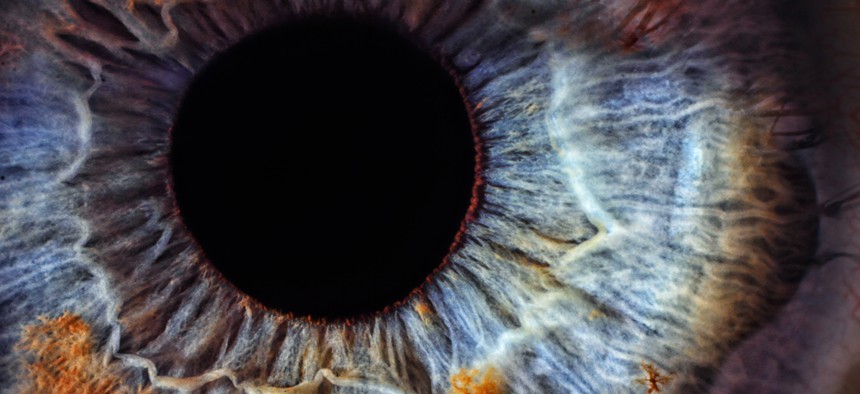Facial Recognition for the People in Your Pupils

Phatic-Photography/Shutterstock.com
Portrait zooms can reveal their photographer.
If you get up really close to someone—or zoom in really close in a photo of that person—you can see what he sees, reflected into your own eyes. It's creepy and cool and occasionally profound: Staring back at you in shiny, convex curves is yourself.
Which is another way of saying what Rob Jenkins says : that "the pupil of the eye is like a black mirror." And it turns out that even tiny, curve-warped faces of people—the people in your pupils—can be identifiable. In a paper newly published in the open-source journal PLoS ONE , Jenkins, a psychologist, and his co-author, Christie Kerr, share a way to turn the eyes, the old windows into the soul, into information. Photographic portraits can lend themselves to facial recognition ... not just of their subjects, but of their photographers.

A lineup-style array of reflected images from the photos used in the researchers' facial recognition task (in which participants were familiar with the face of the psychologist and unfamiliar with the faces of t he bystanders). The correct naming of the familiar face was frequent (90 percent). (Rob Jenkins via Ray Kurzweil AI)
So how do you make that transition? First, you have to zoom in (really, really zoom in) on images of eyes—since, as Jenkins notes , "a face image that is recovered from a reflection in the subject’s eye is about 30,000 times smaller than the subject’s face." Then you have to enhance those zoom-ins to isolate the faces—the " bystander images "—that the human subjects' pupils contain. But even if you do that, the question remains: Are the pupil-mirrored images, given their small size and curvature, even discernible as faces? If the reflection in the eyes is someone other than yourself, can you make out who it is?
To test that, the researchers presented a series of pixellated faces—an average of only 322 pixels each—as part of a face-matching task they administered to subjects. The subjects who were unfamiliar with the bystanders' faces were able to match the pixellated faces to the standard images of them with 71 percent accuracy; when they were familiar with the faces (if the pixellated face belonged to, say, Barack Obama), they performed with 84 percent accuracy.
Those scant pixels, in other words, were enough to identify not just a face, but a particular person.
The researchers' findings, most obviously, have forensic implications: They could be useful for identifying the perpetrators of crimes like kidnapping and sexual abuse, which all too often involve the photographing of victims. The findings could also, however, have implications for the many social networks that have a vested interest in identifying who your friends are. The eyes may be windows to your soul; they can also, when analyzed appropriately, be windows to your social life.
( Image via Phatic-Photography / Shutterstock.com )
NEXT STORY: The Top 5 Government Tech Stories of 2013





